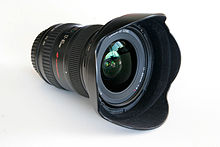Shutter speed determines the amount of time the shutter sensor stays open.
Fast shutter speed freezes motion,
Slow shutter speed blurs motion.
Example
Slow Fast
Shutter priority mode is selected by the TV mode on the camera - Time Value (on the Cannon). This allows you to select a suitable shutter speed, along side the ISO. The camera would select the aperture.
Class Exercise:
TV, ISO 100
Shutter speed 1/200 - subject to wave.
 |
| ISO 100, Shutter Speed 1/10. Freezes hand but too dark. |
 |
| ISO 200, Shutter Speed 1/10. Freezes hand but too dark. |
 |
| ISO 400, Shutter Speed 1/10. Freezes hand but too dark. |
 |
| ISO 800, Shutter Speed 1/200. |
 |
| ISO 1600, Shutter Speed 1/200 |
 |
| ISO 1600, Shutter Speed 1/10. Slow Shutter Speed - Subject still but hand blurred. |
Note: Faster shutter speed to freeze picture/subject eg: sport, but move ISO to go from dark to light.
Lens Choice:
Std Len (Kit Lens)
Variable aperture
usually 18mm-55mm

Pro Zoom
Constant aperture
usually 24mm-70mm
Std Telephoto
usually 70mm-300mm (but these can differ)
Macro switch for closer work
eg. Sport or wildlife

Wide Angle
Constant aperture
usually from 10mm
eg. landscape or estate agents!

Macro Len (Prime Lens)
no zoom
very close work, close focusing
constant aperture
usually 105mm

NOTE: PRIME LEN WILL ALWAYS PRODUCE BETTER QUALITY WORK THAN A ZOOM
Fish Eye (Prime Lens)
very wide angle lens
constant aperture
generally below 10mm

Prime Lens
Varying focal lens
very wide aperture
optimal image quality
individual sizes eg. only 50mm (much better than multi lenses)

NOTE: BETTER TO HAVE A BASIC CAMERA WITH A PRIME LENS RATHER THAN EXCELLENT CAMERA WITH A MULTI LENS
NOTE: IF ON A BUDGET 50MM IS THE BEST PRIME LEN YOU CAN PURCHASE - THEN MOVE TO DIFFERENT SIZES
Class Exercise:
Portraits - long lens unflattering always go as close as you can.
 |
| Subject 28mm, ISO 400 |
 |
| Subject 90mm, ISO 400 |
Macro Photography:
Extreme close up photography.
Using a dedicated macro lens.
Example scale of a model car - generally 1:48
Macro scale should be 1:1
General kit lens Scale 1:6
NOTE: DSLR CAMERAS DO NOT HAVE A 'PROPER' MACRO FUNCTION - ONLY WITH A MACRO LENS CAN YOU ACHIEVE MACRO SCALE. POINT AND CLICK CAMERA ARE MUCH BETTER.
To achieve good macro photography with a DSLR, you would need;
Dedicated macro lens, or close up filter.
Tripod & support.
Good Lighting
Class Exercise: USE MANUAL FOCUS FOR MACRO
 |
| ISO 400, 90mm with Manual Focus |

No comments:
Post a Comment